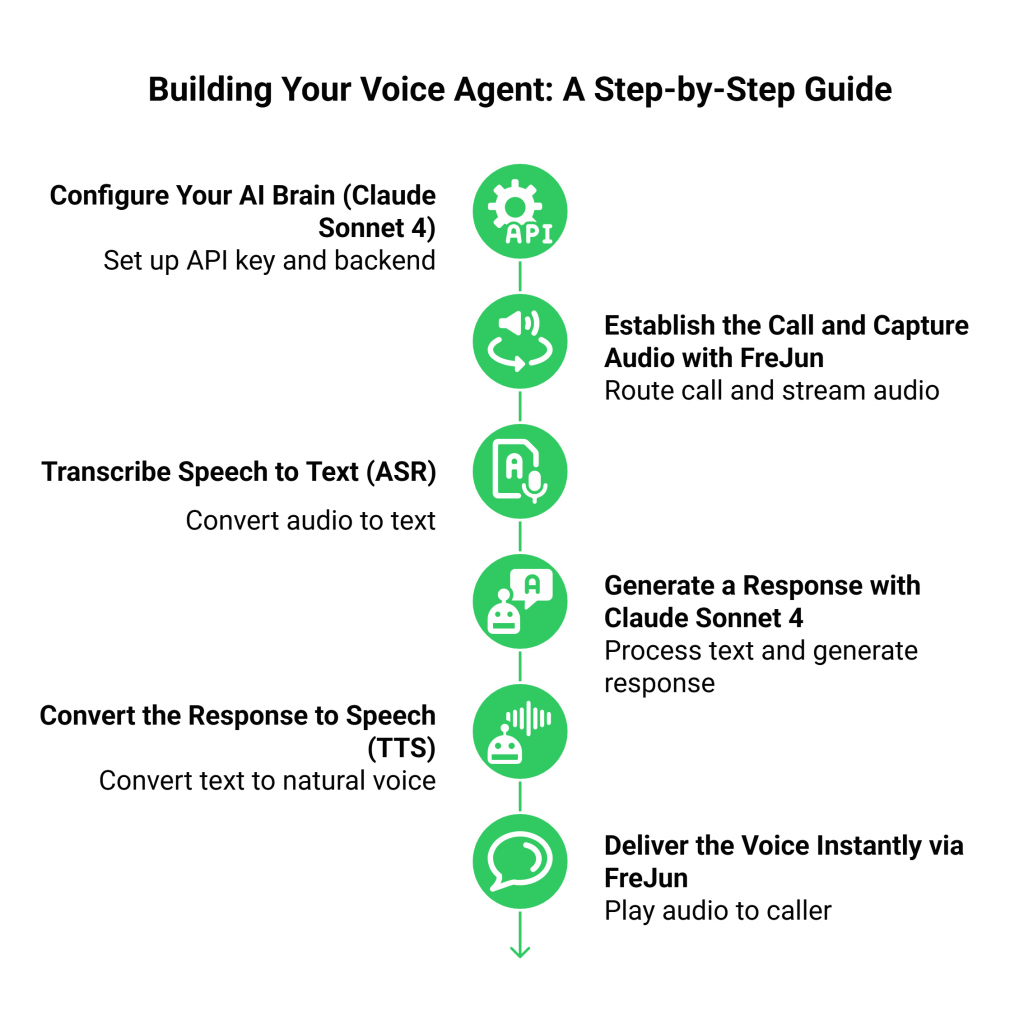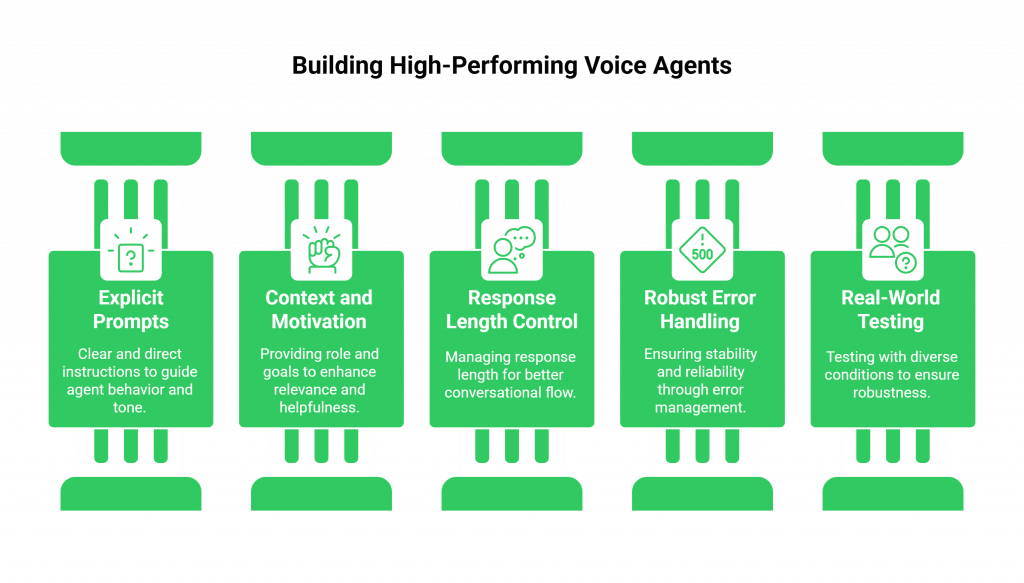For years, the promise of automated customer support has been a story of compromise. Businesses, striving for 24/7 availability, deployed rigid IVR systems and first-generation chatbots. Customers, in turn, navigated frustrating phone trees and interacted with bots that lacked any real understanding of their problems. The ambition was there, but the intelligence was not. These systems could follow a script, but they couldn’t reason, correct errors, or follow complex instructions.
Table of contents
- Why Is Your Voice AI Project Stuck in the Demo Phase?
- FreJun: The Enterprise-Grade Voice for Your AI Brain
- The Production Pipeline: Building Your Voice Agent
- DIY Infrastructure vs. FreJun: A Strategic Comparison
- Best Practices for a High-Performing Voice Agent
- From Advanced Model to Intelligent Business Asset
- Frequently Asked Questions (FAQs)
That era is officially over. The arrival of advanced AI like Anthropic’s Claude Sonnet 4 has set a new, dramatically higher standard for what’s possible. This powerful model excels at nuanced understanding, superior instruction following, and complex, multi-turn conversations. It’s the “brain” businesses have been waiting for, a tool capable of powering sophisticated agents that can handle complex workflows and provide genuinely helpful, context-aware support.
Why Is Your Voice AI Project Stuck in the Demo Phase?
Having a world-class AI brain is a monumental leap forward, but it is only half of the solution. A brilliant AI is useless if it cannot communicate effectively and reliably in the real world. This is where most voice AI projects stall. Development teams, inspired by the power of the Claude Sonnet 4 API, build impressive demos that work flawlessly on a local machine. But the moment they attempt to deploy this AI as a voice bot over a live telephone line, they hit the production wall.
The immense and often underestimated complexity of voice infrastructure creates this gap. Building a system that can reliably connect a phone call to your AI application in real-time is a massive undertaking, filled with critical challenges:
- Crippling Latency: The delay between a customer speaking, the AI processing the audio, and the bot responding is the single greatest enemy of conversational flow. Even a one-second delay feels unnatural and leads to a disjointed, frustrating experience.
- The Scalability Barrier: An application that works for a single test call will collapse under the pressure of hundreds or thousands of concurrent calls during peak business hours.
- Reliability and Uptime: Real-time voice requires a resilient, geographically distributed network to ensure crystal-clear audio and prevent dropped calls. Building and maintaining this is incredibly costly and requires specialized expertise.
These infrastructure hurdles divert your most valuable engineering resources away from what truly matters: designing the best possible conversational experience with your Claude Sonnet 4 AI voice agents.
FreJun: The Enterprise-Grade Voice for Your AI Brain
This is precisely the problem FreJun was built to solve. We believe that businesses should be able to harness the power of world-class AI without the burden of becoming telecommunications experts. FreJun handles the complex voice infrastructure so you can focus on building your AI.
Our platform is the critical bridge that transforms your AI model from a text-based application into a fully functional voice agent. We provide a robust, developer-first API architected from the ground up for the low-latency, high-clarity communication that real-time conversational AI demands. We provide the voice, so you can perfect the intelligence of your Claude Sonnet 4 AI voice agents.
The Production Pipeline: Building Your Voice Agent
Building a production-ready voice agent requires a well-orchestrated pipeline of technologies. Here is a high-level guide to structuring the development process, using FreJun as the foundational voice layer.

Step 1: Configure Your AI Brain (Claude Sonnet 4)
Before the first call, your AI needs to be set up.
- How it Works: Obtain your API key from Anthropic or an integrated platform like ElevenLabs. Configure your backend application to make authenticated POST requests to the Claude API, specifying the model claude-sonnet-4.
Step 2: Establish the Call and Capture Audio with FreJun
The interaction begins when a customer dials your business phone number.
- How it Works: The call is routed through FreJun’s platform. Our API establishes the connection and immediately begins providing your application with a secure, real-time stream of the caller’s raw voice audio. This is the crucial first step that connects the outside world to your bot.
Step 3: Transcribe Speech to Text (ASR)
The raw audio stream from FreJun must be converted into text.
- How it Works: You stream the audio to your chosen Automatic Speech Recognition (ASR) service. The accuracy of this transcription is vital for Claude Sonnet 4’s ability to understand the user’s intent.
Step 4: Generate a Response with Claude Sonnet 4
The transcribed text is fed to your AI model for processing.
- How it Works: Your application sends the user’s text, along with the maintained conversation history, to the Claude Sonnet 4 API. The model’s superior reasoning and instruction-following capabilities allow it to generate a highly relevant and accurate response.
Step 5: Convert the Response to Speech (TTS)
The text from Claude must be converted back into a natural-sounding voice.
- How it Works: The generated text is passed to a Text-to-Speech (TTS) engine. Using a streaming TTS service is essential to begin playback as quickly as possible and reduce perceived latency.
Step 6: Deliver the Voice Instantly via FreJun
The final step is to play the bot’s audio back to the caller.
- How it Works: You pipe the synthesized audio stream from your TTS service directly to the FreJun API. Our platform plays this audio to the caller over the phone line with minimal delay, completing the conversational loop and creating a fluid, natural interaction. This is the final piece of the puzzle for building effective Claude Sonnet 4 AI voice agents.
DIY Infrastructure vs. FreJun: A Strategic Comparison
When you decide to build Claude Sonnet 4 AI voice agents, you face a critical build-vs-buy decision for your voice infrastructure. This choice will define your project’s speed, cost, and ultimate chance of success.
| Feature / Aspect | DIY Telephony Infrastructure | FreJun’s Voice Platform |
| Primary Focus | 80% of your resources are spent on complex telephony, network engineering, and latency optimization. | 100% of your resources are focused on building and refining the AI conversational experience with Claude Sonnet 4. |
| Time to Market | Extremely slow (months to over a year). Requires hiring a team with rare and expensive telecom expertise. | Extremely fast (days to weeks). Our developer-first APIs and SDKs abstract away all the complexity. |
| Latency Management | A constant and difficult battle to minimize the conversational delays that make bots feel robotic and unnatural. | Engineered for low latency. Our entire stack is optimized for the demands of real-time conversational AI. |
| Scalability & Reliability | Requires massive capital investment in redundant hardware, carrier contracts, and 24/7 monitoring. | Built-in. Our platform is built on a resilient, high-availability infrastructure designed to scale with your business from day one. |
| Maintenance | You are responsible for managing carrier relationships, troubleshooting complex failures, and ensuring compliance. | We provide guaranteed uptime, enterprise-grade security, and dedicated integration support from our team of experts. |
Best Practices for a High-Performing Voice Agent
Creating powerful Claude Sonnet 4 AI voice agents goes beyond the initial build. To ensure long-term success, follow these best practices:

- Be Explicit in Your Prompts: Claude Sonnet 4 excels at following instructions. Be clear and direct in your prompts to guide the agent’s behavior, tone, and response format.
- Provide Context and Motivation: In your system prompt, explain the agent’s role and goals. Adding this context helps the model generate more relevant and helpful responses.
- Control Response Length: For voice interactions, concise answers are usually better. Use your prompts to instruct the model to keep responses to a manageable length to improve conversational flow.
- Implement Robust Error Handling: Your application should gracefully handle API errors, manage rate limits, and include retry logic to ensure the voice agent remains stable and reliable.
- Test in Real-World Conditions: Move beyond testing with clean, pre-recorded audio. Use real phone calls and test with diverse accents, background noises, and varying connection quality to ensure your bot is robust and reliable.
From Advanced Model to Intelligent Business Asset
The arrival of models like Claude Sonnet 4 marks a true paradigm shift in business communication. The ability to deploy genuinely intelligent, reasoning AI is no longer a distant vision, it is a practical reality and a powerful competitive advantage. A well-designed voice agent can do more than just answer questions; it can handle complex workflows, improve customer satisfaction, and free up your human agents to focus on high-value interactions.
By building your voice agent on FreJun’s infrastructure, you are making a strategic decision to focus on value, not on plumbing. You are free to harness the full power of one of the world’s most advanced AI models, confident that its voice will be clear, reliable, and ready to scale globally. Stop wrestling with telephony complexity and start building the future of your customer experience. This is how you turn a powerful AI model into a tangible business asset.
Further Reading – Full Guide to Implementing a Voice Activated Chatbot
Frequently Asked Questions (FAQs)
Anthropic developed Claude Sonnet 4 as a highly advanced AI model. It excels at following complex instructions, using tools, correcting errors, and performing advanced reasoning, making it ideal for sophisticated voice agents.
No. FreJun is the specialized voice transport layer. We provide the real-time audio streaming and call management infrastructure. Our platform is model-agnostic, meaning you bring your own AI (like Claude Sonnet 4), ASR, and TTS services. This gives you maximum flexibility and control.
Conversation history provides essential context, enabling the agent to remember past discussions, understand follow-up questions, and deliver personalized responses without making the customer repeat information. This is critical for a non-frustrating experience.
Yes. Platforms like ElevenLabs offer integrated solutions that bundle ASR, the Claude Sonnet 4 model, and TTS. You would still need a platform like FreJun to connect that integrated agent to a real phone number and manage the telephony at scale.
Low latency is essential for a natural conversation. Long delays between a user speaking and the agent replying create awkward silences and lead to users interrupting the agent, causing a frustrating and ineffective experience. FreJun is engineered to minimize this latency.
